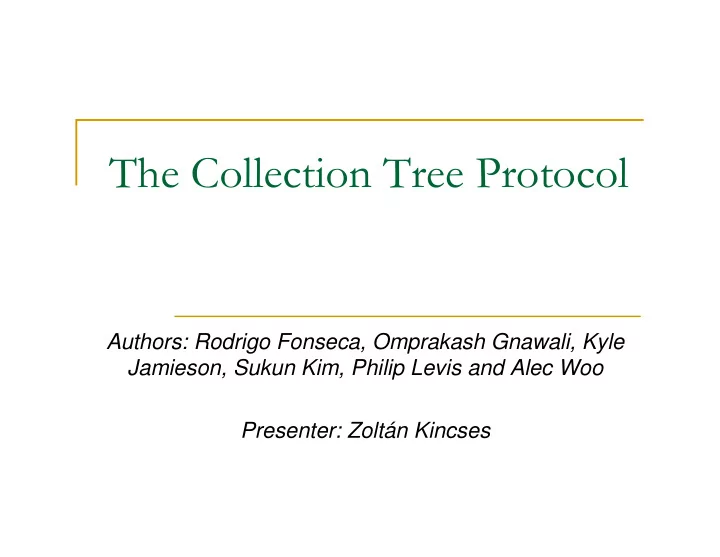

���������������������������� Authors: Rodrigo Fonseca, Omprakash Gnawali, Kyle Jamieson, Sukun Kim, Philip Levis and Alec Woo Presenter: Zoltán Kincses
������������ � The Collection Tree Protocol (CTP) is a tree based protocol with some tree root nodes � CTP is address free � Nodes generate routes to root using rooting gradient � CTP assumes that the data link layer provides: � efficient local broadcast address � synchronous acks for unicast packets � protocol dispatch field (support higher-level protocols) � single-hop source and destination fields
� CTP assumes that it has link quality estimates of some number of nearby neighbors � CTP has several mechanisms in order to improve delivery reliability (not promise 100%) � CTP designed for relatively low traffic
������������������ � CTP uses Expected Transmissions (ETX) as a routing metric � ETX root =0 and ETX node =ETX parent +ETX linktoparent � CTP should choose the route with the lowest ETX � CTP represents ETX as 16-bit fix-point real number with precision of hundredths � Two main problem � Rooting loops � Packet duplication
������������� � Occur when a node choose a new route with higher ETX than its old one � Two mechanisms to address this problem � CTP packet contains a node’s current gradient value � the data frame with lower gradient value indicates inconsistency � try to solve inconsistency by broadcasting a beacon frame � not consider routes with an ETX higher than a reasonable constant
������������������ � Occurs when a node receives a packet successfully but the ack is not received by the sender � The sender retransmits the packet and the receiver receives it a second time � The duplication is exponential � CTP data frames have Time Has Lived (THL) field which was incremented by routing layer
�������������� 1 2 3 4 5 6 7 8 9 10 11 12 13 14 15 16 P C reserved THL ETX origin seqno collect_id data...
� P (Routing Pull) � allows nodes to request routing information � if P is set the node should transmit a routing frame � C (Congestion notification) � if a node drops a CTP data frame it must set the C bit field on the next data frame � THL (Time Has Lived ) � if a node generates a CTP data frame, it must set THL to 0 � if a node receives a CTP data frame must increment the THL
� ETX (Expected Transmissions) � the ETX is the routing metric of the single-hop sender � node send a CTX data frame must put the ETX of its routes � node receives a packet with lower gradient must schedule a routing frame � Seqno � origin sequence number � Collect_id � Higher-level protocol identifier � Data � the data payload, of zero or more bytes
����������������� 1 2 3 4 5 6 7 8 9 10 11 12 13 14 15 16 P C reserved parent parent ETX ETX
� P (Routing Pull) � same as data frame � C (Congestion Notification) � same as data frame � Parent � the node's current parent � Metric � the node’s current routing metric value
� After a node hears a routing frame, it must update its routing table � If a node ETX value changes significantly, should transmit broadcast frame to notify other nodes � The parent can detect when a child ETX is significantly below its own � parent must schedule a routing frame
�������������� � Three major subcomponents � link estimator � responsible for estimating the single-hop ETX of communication with single hop neighbors � routing engine � uses link estimates to decide which neighbor is the next hop routing hop � forwarding engine � maintains queue of packets to send � decides when and if to send them
��������������� � Two mechanism to estimate the link quality � periodic Link Estimation Extension Protocol (LEEP) packets � sends routing beacons as LEEP � seeds the neighbor table � similar to Trickle based dissemination � data packets � direct measure of ETX � estimator produces ETX estimate after 5 successfully acknowledged packet transmission
�������������� � Picking the next hop for data transmission � Keeps track of the path ETX of the subset of the nodes � The minimum cost route has the smallest sum � the path ETX from that node � the link ETX of that node
����������������� � Transmitting, retransmitting packets to the next hop and passing ack based information to the link estimator � Deciding when to transmit packets to the next hop � Detecting routing inconsistencies and informing the routing engine � Maintaining a queue of packets to transmit (local and forwarded) � Detection singe-hop transmission duplicates
� SubReceive.receive() � decides whether or not the node should forward a packet � calls the forwarding functions � forward() � formats the packet for forwarding � checks if there is a possibly loop in the network � checks if there is space in the queue � if not C bit is set � if yes post send task
� sendTask() � examines the packet in the send queue, formats it and submits it to the AM layer � sendDone() � examines the packet to see the results � if ack received pulls of the packet from the queue � if packet was locally generated is signals sendDone() � if there are packets remaining in the queue it starts a randomized timer that reposts this task
Thank you for your kind attention!
Recommend
More recommend